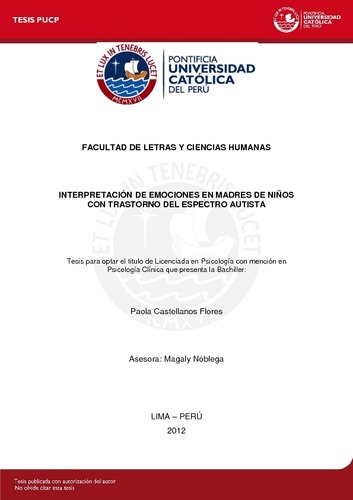Interpretación de emociones en madres de niños con trastorno del espectro autista
Abstract
La presente investigación tiene como objetivo describir las características de la
interpretación de emociones en un grupo de madres de niños con trastorno del
espectro autista (TEA). Para ello, se contó con la participación de 30 madres entre 25
y 49 años (M = 34.9, DE = 6.25) cuyos hijos, con edades entre 2 y 10 años (M=5.87;
DE=2.48), han sido diagnosticados con TEA. La interpretación de emociones se
evaluó con la versión peruana del I FEEL PICTURES (Traverso & Nóblega, 2008). Los
resultados obtenidos muestran que las madres de niños con TEA reportan mayor
frecuencia en las categorías de Cólera y Emociones Mezcladas, y menor frecuencia en
las de Alegría, Tristeza y Vergüenza; con respecto a un grupo comparativo de madres
de niños con desarrollo típico tomado de un estudio peruano. Además, las madres de
niños con TEA difieren entre sí en la frecuencia de respuestas en la categoría de
Pasividad de acuerdo a su grado de instrucción; y en la de Tristeza, dependiendo de la
edad de sus hijos, y de su participación en grupos de orientación sobre niños con TEA.
Por otro lado, las madres del estudio reportan una gama de respuestas particulares
dentro de la categoría de Emociones Mezcladas, cualitativamente significativas dadas
las características particulares del grupo de estudio. Estas respuestas se clasificaron
en sub categorías que se describen y discuten en la investigación. This research aims to describe the characteristics of the interpretation of emotions in a
group of mothers of children with autism spectrum disorder (ASD). Participants of this
study were composed by a group of 30 mothers between 25 and 49 years (M = 34.9,
SD = 6.25) whose children, aged between 2 and 10 years (M = 5.87, SD = 2.48) have
been diagnosed with ASD. Interpretation of emotions was assessed with the Peruvian
version of I FEEL PICTURES (Traverso & Nóblega, 2008). The results show that
mothers of children with ASD most frequently report categories of Anger and
Mixed Emotions, and less frequently report those of Joy, Sadness and Shame,
regarding to a comparison group of mothers of typically developed children taken from
a peruvian study. In addition, mothers of children with ASD differ among themselves
in the frequency of responses in the category of Passive according to their level of
education; and that of Sadness, depending on the age of their children, and on their
participation in counseling groups about children with ASD. On the other hand,
mothers in this study report a range of responses that correspond to the category of
Mixed Emotions, but are qualitatively significant given the particular characteristics of
the study group. These responses were classified into sub categories which are
described and discussed in the research.
Temas
Emociones
Madres--Aspectos psicológicos
Niños autistas
Madres--Aspectos psicológicos
Niños autistas
Para optar el título de
Licenciado en Psicología Clínica






